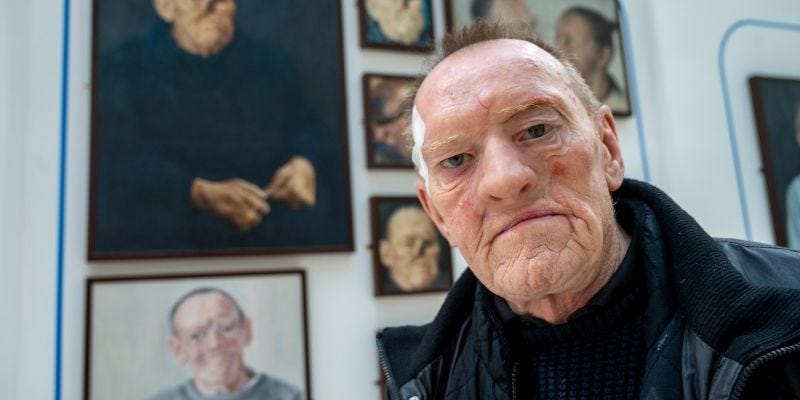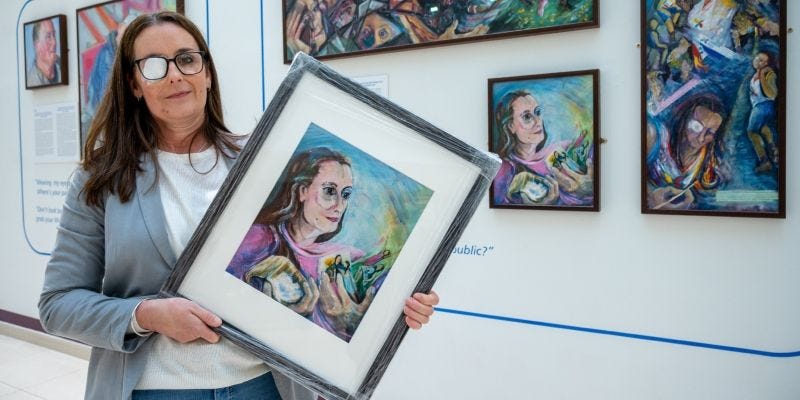“Cancer has many faces: This is mine”
The 'I'm Still Me' portrait exhibition in Leeds offers a poignant reflection on cancer and facial difference

NEVER judge a book by its cover, is the timeless cliché, but when it comes to people we too often fail to look past their features to see the person they are.
That's why an exhibition of portraits currently on display in Leeds, West Yorkshire, offers up an especially poignant reminder that the qualities that make us human are deeper than skin.
The paintings don't depict celebrities or politicians, but ordinary people who have been forced to come to terms with significant changes to their facial appearance; a legacy of treatment for head and neck cancers.
The exhibition features 15 patients who wear facial prosthetics. These are removable, custom-made silicone devices that replace parts such as an eye or a nose. The paintings serve to provide a sympathetic – and empathetic – illustration of the physical and psychological impact of living with facial difference.
“Head and neck cancer can have a major impact on a patient’s health and well-being, and receiving a prosthesis can be an important part of the process of coming to terms with the experience,” said Dr Rachael Jablonski, from the University of Leeds' School of Dentistry, whose trial study inspired the exhibition.
In a very real sense, it's about challenging stigma around difference. The exhibition serves a reminder to the viewer that the people depicted remain human beings, albeit people coming to terms not only with the legacy of cancer, but also the reaction their altered features sometimes instil in others (and, indeed, their own sense of self). Those reactions are not necessarily pretty, as the subjects of the exhibition can testify.
“I find the patients have been truly inspirational in sharing their ongoing stories about rehabilitation with a facial prosthesis,” said Sue Pavitt, professor of translational and applied health research at the School of Dentistry.
“The ignorance and inappropriate comments the public make to them begs belief. They have shared the challenges and their grief at losing their face as they recognise it, their loss of confidence with their changed identity, dealing with people staring, and often cruel comments.”
The portraits were painted as part of a public engagement project, named I'm Still Me, which was associated with a study trial that explored more cost-effective ways of making prosthetics, and identifying which techniques patients preferred.

I'm Still Me was inspired by the research – in which all the featured people took part – and was co-created by the patients, researchers, healthcare professionals, and others involved in the project.
“The I’m Still Me exhibition is a powerful reminder of the courage and resilience shown by patients who navigate life with facial prostheses,” said professor Shearer West, vice-chancellor and president of the University of Leeds.
“The collaboration between patients, artists, and researchers shines a light on both the scientific advancements in prosthesis technology and the personal journeys of those affected.”
The IMPRESSeD study that inspired the exhibition was funded by the National Institute for Health & Care Research (NIHR), along with Leeds Hospitals Charity, and was led by Jablonski as part of her PhD. She is now current NIHR academic clinical lecturer, and speciality registrar in restorative dentistry at the School of Dentistry and the Leeds Dental Institute,
The public engagement project itself was funded by Research England’s Enhancing Research Culture funding stream, with additional support provided by a University of Leeds Engagement Fellowship.
Making a face
The conventional process for manufacturing a prosthesis involves multiple clinical and laboratory procedures over several hospital visits with highly trained maxillofacial prosthetists, who recreate the facial part.
Firstly, an impression of the patient’s face is taken using a silicone or alginate material. This can be claustrophobic or uncomfortable, and may distort the facial tissues, affecting the final product, the study team explain.
Specialists called maxillofacial prosthetists use the impression to pour a plaster model, hand-sculpt a wax pattern, then convert it into a silicone prosthesis.
Replacements are needed every two years, but sometimes as often as soon as six months, due to changes in the patient’s face during the healing process; prosthesis wear and tear also plays a part, as does general degradation. Estimates suggest that the process can take up to 10 hours to complete and cost up to £1,500.
New facial prosthesis manufacturing techniques employ 3D facial scanning as a less invasive way of capturing the shape and texture of a patient’s face, as well as computer-aided design using artificial intelligence to reconstruct the facial feature, and 3D printing of the design to help produce the prosthesis.
According to the team, digital technologies have the potential to support or replace steps in the manufacturing processes, potentially helping to address pressures on the small numbers of qualified maxillofacial prosthetists working in the NHS.
Jablonski worked with patients to identify priority areas for improving the manufacturing process. These were identified as getting rid of uncomfortable facial impressions; more closely matching the way a patient's face looked before surgery; and receiving their prosthesis sooner after surgery.
Patients from Leeds Teaching Hospitals NHS Trust and Guy’s and St Thomas’ NHS Foundation Trust in London received facial prostheses made using conventional and digital manufacturing approaches. They were asked to assess both methods towards the end of the study.
“We found that 90% of patients we interviewed preferred digital over conventional processes due to the comfort, speed, hygiene, and perceived positive impact on outcomes associated with digital technology,” Jablonski said.
“Some patients felt contactless scanning may offer benefits when a patient’s skin is sore after surgery or radiotherapy, and others considered the computer-aided design technology and 3D printing to be sophisticated and a positive step forward.
“However, the patients were also keen to ensure they would not lose out on the skilled finishing touches from the conventional approach.”

Opening eyes
I’m Still Me was created as a collaborative arts-science project to share the lived experience of people who wear facial prostheses, bring the research findings out into the wider community, and highlight the valuable role of patients in research and public engagement.
The portraits were created by a group of painters assembled by Salford artist Sarah Morley following her work on a similar, previous project.
Together with writers and researchers, the artists worked with the patients to co-design the exhibition. Each portrait is displayed alongside a narrative describing the patient’s rehabilitation with facial prostheses. The aim is to highlight the innovative science involved, and – perhaps more pertinently – to raise public awareness about face equality.
“Research is typically not very accessible to the general public,” Jablonski said. “We knew that when we shared the research, we wanted to make the findings as accessible as possible.
“There has also traditionally been an under-representation of people with visible differences in public life and the media. It was therefore important that the project not only shared our research findings, but also communicated key issues that were most important to the patient contributors.
“We hope that I’m Still Me shares messages of face equality and stimulates a reflection on how people should be valued through their own unique stories and contributions.”
Pavitt added: “It has been an immensely thought-provoking project to be involved with, and I hope it starts a public debate about face equality. Patient Robin says: ‘Cancer has many faces, this is mine.’ This sums up the I’m Still Me exhibition.”
The portraits are currently exhibited in the Atrium of the Bexley Wing at St James Hospital, Leeds, West Yorkshire, and runs until 31 January.
MC



